“Ideas matter. Emerging from specific human, historical, and technological contexts, ideas affect understanding and influence behavior. Ideas can serve as the driving force behind significant institutional change. Because the need for change will always be with us, the exchange of ideas and conceptual development must be among our top priorities.”[1]
Sound thinking; ideas do matter. As stated above, “ideas can serve as the driving force behind significant institutional change.”[2] Consistent with this view, few would challenge the assertion that the United States Army is one of the most capable and effective “learning organizations”[3] that exist within the United States, military or civilian. One can easily reflect on the Army’s learning and adaptation over the last ten years of combat due to the demand for a more rapid introduction of doctrine and doctrinal concepts sufficient to the needs of the operational formation. Unfortunately, we must acknowledge that there is in fact a difference between positive change, and change that creates chaos, confusion and disruption within the ranks. When formal introduction of ideas ultimately become more like “square pegs being driven into round holes”, we have an obligation to assess and reflect on the idea in context, make judgment on its continued value in application and make bold, sweeping adjustments as necessary to prevent continued chaos and confusion within the ranks of the Army. We have several recent historical examples of “doctrinal reflection points” resultant from “square peg ideas” like the original distinction of CMETL-DMETL and the initial introduction of Design, both of which required institutional course corrections in a very short period of time after being formally codified and published in the Army’s foundational doctrine. With the recent introduction of U.S. Army Doctrine 2015 and the first formally published Army Doctrine Publication (ADP), ADP No. 3-0, Unified Land Operations dated 10 October 2011, we find ourselves at a similar “doctrinal reflection point”.
The purpose of this article is to explore the latest “square peg idea” within Army doctrine by identifying and outlining the obvious clutter and confusion being generated by the introduction of the Army’s newest operational concept known as Unified Land Operations (ULO). In fairness and with supportive acknowledgement, the overarching premise of ULO in and of itself is sound and is a solid direction for the U.S. Army. The concept provides a distinct and clear description of the purpose of the Army and its contributions to Unified Action and the anticipated needs of our nation. However, there is a clutter within the concept due to ambiguity and the overlap of ideas communicated by the distinct sub-components of ULO which is causing confusion within the serving formation. Specifically, the “old” idea of Full Spectrum Operations (FSO) [now known as Decisive Action (DA)] and the “novel” ideas presented as the Army Core Competencies of Combined Arms Maneuver (CAM) and Wide Area Security (WAS) are sufficiently similar in thinking that there is a developing struggle to separate and operationalize the ideas as intended. With this acknowledgement, this article argues that the Army must clearly define the relationship between DA and the newly described core competencies and our recently published doctrine does not meet that obligation. Therefore, the Army is now faced with three possible solutions to this problem as potential “ways ahead”. These solutions include; (1) do nothing and allow the formation to struggle with the ill-defined, misunderstood and competing sub-component “ideas” of the ULO construct, (2) adapt, modify and “reframe” the construct and sub-component “ideas” in order to retain the fundamental vision as originally intended or (3) completely redefine the construct as we did with the transition from Full Spectrum Operations (FSO) to ULO by removing one of the two competing sub-component “ideas”.
Option 1 – do nothing and allow the formation to struggle with the ill-defined and misunderstood sub-component “ideas” of the ULO construct. In order to make judgment on this course of action, first we need to explore the published construct of ULO, its sub-components and identify why the confusion as claimed by this article is emerging in the serving formation. In the preface of ADP No. 3-0, the U.S. Army Combined Arms Doctrine Directorate (CADD) presents a graphic that represents the “underlying logic” of ULO (see ADP No. 3-0, Figure 1). This section will challenge the logic and sub-components as presented by this “logic map”. [During a presentation on 24 April 2012 by the U.S. Army Combined Arms Doctrine Directorate (CADD) to the Department of Army Tactics (DTAC), Command and General Staff School (CGSS) the briefer referred to Figure 1 of ADP No. 3-0 as a “logic map”. This article will use the same label for purposes of discussion.]
In accordance with ADP No. 3-0, ULO is described as “….how the Army seizes, retains, and exploits the initiative to gain and maintain a position of relative advantage in sustained land operations through simultaneous offensive, defensive, and stability operations in order to prevent or deter conflict, prevail in war, and create the conditions for favorable conflict resolution.”[4] However, in the “logic map” contained within ADP No. 3-0 (Figure 1) the visual representation of this description is slightly reorganized by presenting Decisive Action and the Army Core Competencies as sub-componentsof the ULO construct leaving the now separated and overarching principle of ULO more refined and more representative of the traditional approach utilized by the U.S. Army as a task/purpose statement construct (see Figure 1)[5].
Although more concise and intended to provide greater clarity, the first issue resulting from this rewording of the overarching description is the blurring of two tasks and two purposes. As written one may see the task of ULO as to “seize, retain, and exploit the initiative” with a purpose to “gain and maintain a position of relative advantage in sustained land operations”. However, the overarching purpose of ULO is to “create the conditions for favorable conflict resolution”. So, another way to view this description (and what is believed to be the developing interpretation of ULO in the serving formation) is more like task-1 of ULO is to “seize, retain, and exploit the initiative” and task-2 of ULO is to “gain and maintain a position of relative advantage in sustained land operations” with a singular purpose to “create the conditions for favorable conflict resolution”. This is important for the argument presented within this article because the description of ULO has a direct bearing on the description, definition, relationships and understanding of the ULO sub-components of Decisive Action (DA) and the Army Core Competencies of Combined Arms Maneuver (CAM) and Wide Area Security (WAS). Therefore, if one accepts that there are in fact two primary ULO tasks that “create conditions for favorable conflict resolution” in accordance with the ULO construct, then we need to understand how DA and the Army Core Competencies (CAM and WAS) complement and reinforce each other related to these tasks and herein lies the confusion.
As we follow the logic map (and review what was expressed in the textual description of ULO), the construct states that we execute the tasks of “….seize, retain, and exploit the initiative” and “ gain and maintain a position of relative advantage in sustained land operations”[6] through the “….the simultaneous combination of offensive, defensive, and stability operations….appropriate to the mission and environment.”[7] This thinking is consistent with the same idea previously known as Full Spectrum Operations (FSO) that was initially introduced to the Army formation in 2001. Subsequent to 9/11 and resultant from the operational experiences in early Iraq and Afghanistan, the Army made major institutional investments to inculcate the serving formation’s understanding of FSO and through operational application this foundational, operational concept in fact created the desired effect of “significant institutional change”.[8] Therefore, it is safe to assume the fundamental idea of Decisive Action (old FSO)[9] in and of itself is not problematic with the current serving formation (even though the decision to rename FSO is questionable).
What is problematic is the introduction of the “novel” idea of Army Core Competencies (CAM and WAS) which are for the most part easily interpreted as another way of expressing the “simultaneous combination of offensive, defensive, and stability operations”[10] as described in the definition of ULO. ADP No. 3-0 (Oct 11) defines the core competencies as follows: “Combined arms maneuver is the application of the elements of combat power in unified action to defeat enemy ground forces; to seize, occupy, and defend land areas; and to achieve physical, temporal, and psychological advantages over the enemy to seize and exploit the initiative…..Wide area security is the application of the elements of combat power in unified action to protect populations, forces, infrastructure, and activities; to deny the enemy positions of advantage; and to consolidate gains in order to retain the initiative.”[11] However, ADP No. 3-0 further expresses two other characteristics related to the core competencies generating the confusion. First, the doctrine states, “Offensive, defensive, and stability operations each requires a combination of combined arms maneuver and wide area security; neither core competency is adequate in isolation.”[12] Second, the doctrine states, “While an individual tactical action may be predominately characterized as reflecting either combined arms maneuver or wide area security, campaigns and operations invariably combine both core competencies. For example, an offensive operation often features wide area security employed as an economy of force measure, allowing for the concentration of combat power for combined arms maneuver.”[13] These descriptions are precipitating the clutter and confusion within the formation. Through ten years of operational application resulting in an intense doctrinal investment, it is acknowledged (and internalized) that the Army does not conduct any singular type of operation in isolation. All military actions in today’s and the anticipated future operational environments (OEs) will have “simultaneous combinations of offensive, defensive and stability operations.”[14] With that understanding, the Army as an institution must decide on its way forward and the remainder of this article addresses two other possible options to the Army to overcome the current clutter and confusion within the ULO construct.
Option 2 – adapt, modify and “reframe” the construct and sub-component “ideas” in order to retain the fundamental vision as originally intended. Resuming the previous discussion and interpretation of the described tasks and purpose contained within the ULO description, a possible course of action is to change the hierarchy as currently presented. If we break down the current construct using an adaptation of joint service doctrine Ends-Ways-Means[15] analysis it might inform a modified relationship between DA and the core competencies resulting in a greater understanding of the entire construct.
The first action is to ensure we have clarity on the desired (ends) of ULO. If we start our analysis with the current overarching description of ULO and subsequently separate the stated tasks from the true overarching purpose (ends), it is logical that we must completely separate these tasks from the (ends). For the purpose of this analysis, these tasks subsequently become the (ways) to achieve the desired (ends) (see Figure 2).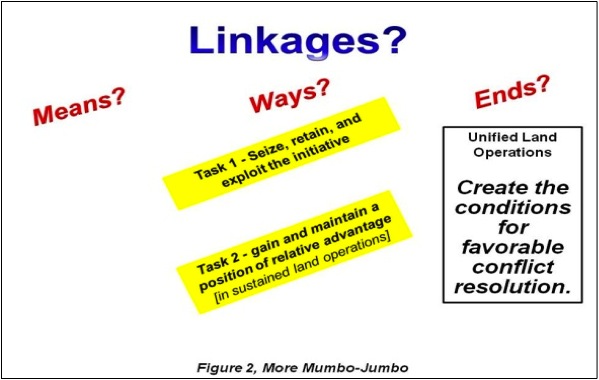
A recommended modification to the current construct is to use the Army Core Competencies (CAM and WAS) as the doctrinal concepts that relate to these two distinct and now separated tasks (ways) (see Figure 3).
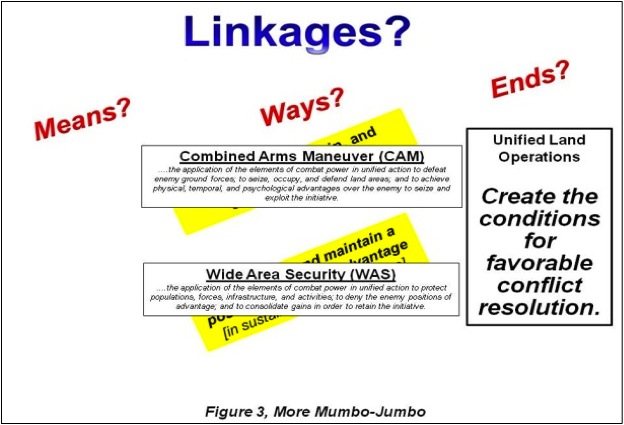
At this point we use an adaptation to the Ends-Ways-Means model by using Decisive Action (DA) as an adapted “means” for the purpose of reorganizing the ULO construct (see Figure 4).
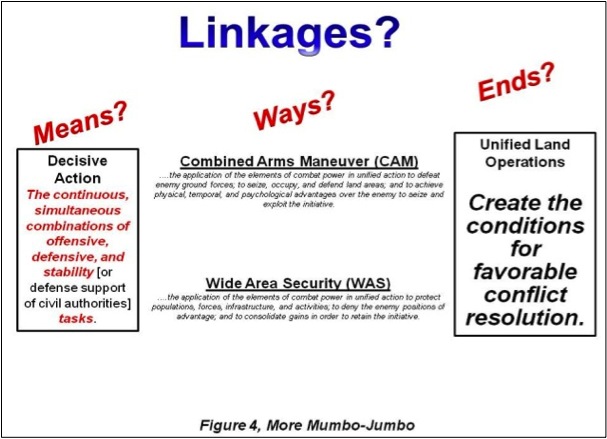
In order to ensure we do not lose the last ten years of learning related to the previous operational concept of FSO which is now diluted by the competing ideas of DA and the core competencies, we can clear up the clutter and confusion by retaining the fundamental principle of DA (old FSO) by subordinating it to the core competencies (see Figure 5).
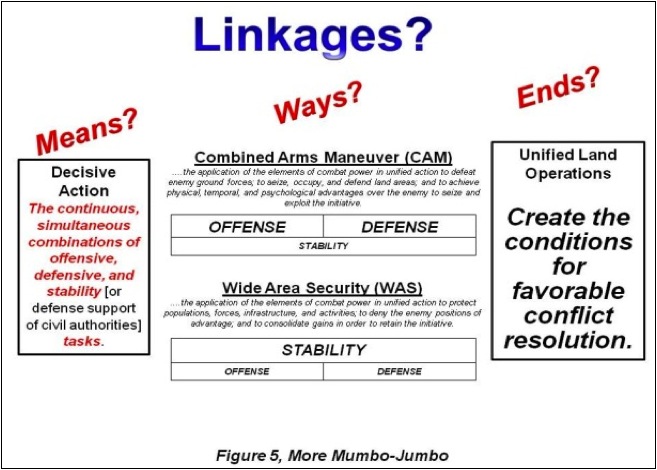 It is important to note at this point that although not well described in current and anticipated doctrine, CADD has provided numerous doctrine updates and presentations that emphasize the following regarding the core competencies; “Combined arms maneuver primarily employs defeat mechanisms against enemies and is dominated by offensive and defensive tasks…..Wide area security primarily employs stability mechanisms against enemies and is dominated by stability tasks.”[16] Said another way, Decisive Action (DA) is inherent in each core competency and not the other way around.
It is important to note at this point that although not well described in current and anticipated doctrine, CADD has provided numerous doctrine updates and presentations that emphasize the following regarding the core competencies; “Combined arms maneuver primarily employs defeat mechanisms against enemies and is dominated by offensive and defensive tasks…..Wide area security primarily employs stability mechanisms against enemies and is dominated by stability tasks.”[16] Said another way, Decisive Action (DA) is inherent in each core competency and not the other way around.
If this logic is sound, we would be better off by making an adaptation to the ULO construct that puts primacy in the construct on the core competencies, their role in ULO and contributions to Unified Action as represented in Figure 6.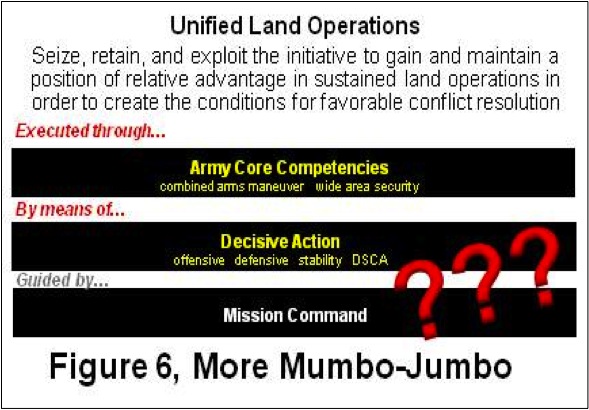
However, if we cannot better define the linkages and relationships between DA and the core competencies, we would be better served to make a clean break and eradicate one from our doctrinal lexicon to relieve the current clutter and confusion within the serving formation. [It should be noted that during the course of researching this article, the author was presented a draft “issue paper” entitled FM 3-0 Issue Paper: Combined Arms Maneuver and Wide Area Security.[17] This writing provides insight to some initial thinking related to the integration of the emergent ideas regarding CAM and WAS as described in TRADOC Pamphlet 525-3-1, The United States Operating Concept 2016-2028, dated 19 August 2010. The stated purpose of the issue paper was to “….recommend[s] a way to incorporate the central ideas of the Army Operating Concept into future Army doctrine.”[18] It is the opinion of the author that we may have lost something in translation between TRADOC PAM 525-3-1, the draft FM 3-0 Issue Paper and the resultant publication of ADP NO. 3-0, Unified Land Operations. The issue paper states the following: “The Army’s operational concept is full spectrum operations: Army forces conduct combined arms maneuver and wide area security through simultaneous combinations of offensive, defensive, and stability or civil support tasks using combined arms to seize, retain, and exploit the initiative, accepting prudent risk to create opportunities and achieve decisive results.”[19] Said another way, “Army forces execute combined arms maneuver and wide area security by means of simultaneous combinations of offensive, defensive, and stability or civil support tasks….” If this was in fact the visualization of the relationship between the core competencies and DA, the recommendation proposed by Option 2 is reasonable and a potential adaption of current published doctrine.]
Option 3 – completely redefine the construct as we did with the transition from Full Spectrum Operations (FSO) to ULO by removing one of the two competing sub-component “ideas”. If we agree that there is in fact “clutter and confusion ” in the serving formation due to the overlapping ideas represented by the core competencies of CAM-WAS and DA and we cannot find a logical way to express the linkages and relationships between the two, then our only recourse is to make a bold, doctrinal shift as we did in the recent history of our doctrine [ie, deletion of CMETL-DMETL, adaptation of Design to Army Design Methodology (ADM), etc].
That said, if we have to choose between the two (either the core competencies or DA), the most logical choice would be to remove the core competencies as currently communicated (see Figure 7).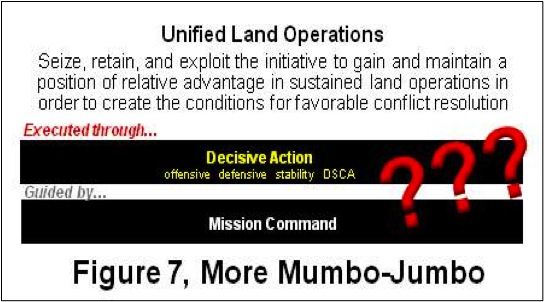
As previously stated, the Army made huge investments over the last ten years with the introduction, refinement, and inculcation of Full Spectrum Operations (FSO) [now entitled Decisive Action (DA)]. The serving formation made the appropriate adaptations of FSO in the Iraq and Afghanistan operational theaters, the concept served the force well and a return to what is already known and inculcated within the formation would be less challenging for the force. Assuming this is in fact a reasonable course of action which is a bold adaptation of recently published doctrine, the Army might also be well served to delete Decisive Action (DA) from our lexicon and return to FSO which is already well understood within the currently serving formation.
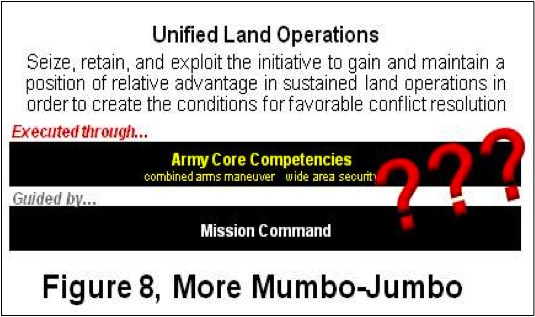
The alternative is to retain the newly introduced core competencies with an acknowledgement and emphasis that simultaneous combinations of offensive, defensive and stability operations are inherent within each competency (see Figure 8).
Of course this is a bold shift away from the ten years of doctrinal evolution and investment in FSO. However, if we successfully describe the foundational ideas of each competency and effectively communicate the original concept of FSO (now DA) as components of each competency, our currently serving formation and future generations should internalize these new doctrinal concepts without risk of returning to the perceived primacy of offensive and defensive tasks over those required for sustained stability operations.
Importantly, adopting this particular approach requires acknowledgement of the challenges related to the core competencies regarding linkages and relationships in ULO. Consistent with the evolution of FSO we also have an emerging visualization of the Army’s role in Unified Action described by the core competencies. Although convoluted by continuing expressions of simultaneous application of CAM and WAS [which this article argues is already described by the idea of DA (FSO)], the “logic” of ULO actually implies transitions over time related to conditions in the environment (seize, retain and exploit the initiative to gain and maintain a position of relative advantage). This representation ultimately translates to a primacy and sequence of Army action(s). In the simplest terms of interpretation, we seize and exploit the initiative through CAM and gain and maintain a position of advantage through WAS (see Figure 9).
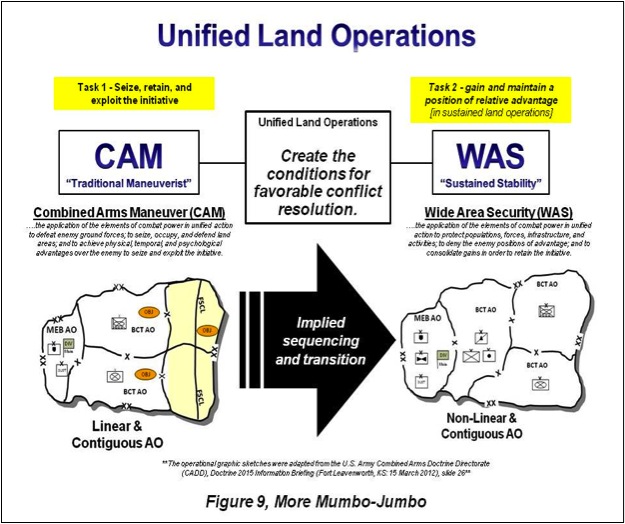
We have struggled with this particular aspect of our visualization of what the Army does (or needs to be prepared to do) in today’s and the anticipated future operational environments. Our recent historical doctrine (FM 3-0, Operations, 2008) originally presented what was commonly referred to as the “Tennessee” chart. The graphic represented a “spectrum of conflict”[20] and supporting operational themes. Ultimately the “Tennessee” chart became problematic internal and external to the Army based on competition between FSO messaging emphasizing simultaneity and the concept of operational themes because the published, doctrinal definition itself stated that, “An operational theme describes the character of the dominant major operation being conducted at any time within a land force commander’s area of operations.”[21] As described in the FM 3-0 Issue Paper, “Change 1 to the 2008 edition of FM 3-0 (FM 3-0, C1) ….removes the so-called “Tennessee” chart depicting the spectrum of conflict and operational themes. Among the main reasons for this change was the tendency of this graphic to portray Army operations as “either-or” propositions depending on the alleged location of a given conflict on the spectrum and the operational theme in play. The most typical example of this tension is the false choice between major combat operations and irregular warfare or counterinsurgency.”[22] With the introduction of CAM-WAS, it seems as though we are now trying to find a creative way to overcome the same obstacle regarding the competencies (or “false choice” as claimed above). In multiple introductory CADD presentations and emerging published doctrine describing ULO the Army’s current messaging is emphatic that CAM-WAS are not mutually exclusive and we do both simultaneously. However, if each competency already includes simultaneous combinations of offensive, defensive and stability tasks doesn’t that in essence say the same thing?
Consistent and related to the argument of this article, the Army would be well suited to acknowledge that the operations the Army has been and will be employed in are in fact dominated by one competency at a time and we do not do both (CAM-WAS) simultaneously. We fight to seize control and dominate the environment through “traditional maneuverist”[23] actions (ie, combined arms maneuver). This is the most important competency of the Army as acknowledged in TRADOC PAM 525-3-1, The United States Army Operating Concept, 2016-2018 dated 19 August 2010. It states, “Combined arms maneuver is the application of the elements of combat power in a complementary and reinforcing manner to achieve physical, temporal, or psychological advantages over the enemy, preserve freedom of action, and exploit success….. Army forces’ ability to conduct combined arms maneuver to achieve these advantages will remain the Army’s most fundamental and important competency. “[24] However, at a point in all operations as informed by the last ten years of operational experience the formation will transition to wide area security which is dominated by “sustained stability operations”[25] and activities. This specified transition is logical and since we already acknowledge that regardless of the dominant action (CAM or WAS) there are simultaneous offensive, defensive and stability tasks there is no longer a need to say we do simultaneous CAM-WAS.
In closing, “ideas matter”[26] and more importantly “ideas can serve as the driving force behind significant institutional change.”[27] Although embraced as a sound philosophy, the recently introduced “logic within the ULO construct” is cluttered and causing confusion within the serving formation due to two reasons. First, the sub-components of the ULO construct are ill-defined and contain overlapping “ideas”. Specifically, the old idea of FSO [now Decisive Action (DA)] which emphasizes how all operations include simultaneous combinations of offensive, defensive and stability tasks is in direct competition with the novel idea of the Army Core Competencies (CAM-WAS) which also attempts to emphasize simultaneity. Second, the ULO construct offers little in the way of describing how DA and the Core Competencies relate to each other.
Accordingly the Army has reached another “doctrinal reflection point” resulting from the rapid introduction of these developing “square peg ideas” and is faced with three options on its way forward relative to what is professed as the newly described operational concept of Unified Land Operations (ULO); (1) chose to do nothing and allow the formation to struggle with the ill-defined, misunderstood and competing sub-component “ideas” of the ULO construct, (2) adapt, modify and “reframe” the construct and sub-component “ideas” in order to retain the fundamental vision as originally intended or (3) completely redefine the construct as we did with the transition from Full Spectrum Operations (FSO) to ULO by removing one of the two competing sub-component “ideas”. Even though Option 1 is in fact feasible, we have been faced with bold adaptations to immature doctrine in our recent past and the Army would be well served to chose Option 2 or 3 as opposed to allowing the “clutter and confusion” within the current ULO construct to grow within the serving formation.
[1] U.S. Army, Training and Doctrine Command (TRADOC) Pamphlet 525-3-0, The Army Capstone Concept, Operational Adaptability: Operating under Conditions of Uncertainty and Complexity in an Era of Persistent Conflict (Fort Monroe, VA: Training and Doctrine Command, 21 December 2009): p. i.
[2] Ibid.
[3] Learning Organization definition - “[An] Organization that acquires knowledge and innovates fast enough to survive and thrive in a rapidly changing environment. Learning organizations (1) create a culture that encourages and supports continuous employee learning, critical thinking, and risk taking with new ideas, (2) allow mistakes, and value employee contributions, (3) learn from experience and experiment, and (4) disseminate the new knowledge throughout the organization for incorporation into day-to-day activities.” Online at < http://www.businessdictionary.com/definition/learning-organization.html> accessed on 24 April 2012.
[4] ADP NO. 3-0, p. 1.
[5] This graphic is a modified extract from ADP NO. 3-0, Figure 1. Unified land operations underlying logic, p. iii-iv.
[6]ADP NO. 3-0, p. 1. Interpreted from the definition of Unified Land Operations (ULO).
[7] Ibid, p. 5. Although not formally presented as the definition of Decisive Action, ADP NO. 3-0, paragraph 21 states the following, “Army forces conduct decisive and sustainable land operations through the simultaneous combination of offensive, defensive, and stability operations (or defense support of civil authorities) appropriate to the mission and environment.”
[8] TRADOC Pamphlet 525-3-0, p. i.
[9] U.S. Field Manual (FM) 3-0, Operations (Washington, DC: Government Printing Office [GPO], 27 February 2008), p. 3-1. “The Army’s operational concept is full spectrum operations: Army forces combine offensive, defensive, and stability or civil support operations simultaneously as part of an interdependent joint force to seize, retain, and exploit the initiative, accepting prudent risk to create opportunities to achieve decisive results.”
[10] ADP NO. 3-0, p. 5.
[11] Ibid, p. 6.
[12] Ibid, p. 6.
[13] Ibid, p. 6.
[14] Ibid, p. 5.
[15] Joint Publication (JP) 5-0, Joint Operation Planning (Washington, DC: Government Printing Office [GPO], 11 August 2011), p. III-1. “Through operational art, commanders link ends, ways, and means to achieve the desired end state….This requires commanders to answer the following questions: (1) What is the military end state that must be achieved, how is it related to the strategic end state, and what objectives must be achieved to enable that end state? (Ends) (2) What sequence of actions is most likely to achieve those objectives and the end state? (Ways) (3) What resources are required to accomplish that sequence of actions within given or requested resources? (Means)”
[16] U.S. Army Combined Arms Doctrine Directorate (CADD), Doctrine 2015 Information Briefing presented to Department of Army Tactics (DTAC), Command and General Staff School (CGSS) on 24 April 2012, slides 19 and 20.
[17]U.S. Army Combined Arms Doctrine Directorate (CADD), FM 3-0 Issue Paper: Combined Arms Maneuver and Wide Area Security, 27 January 2011. Although draft and unpublished this issue paper seems to support to the argument for a change in the proposed primacy relationships between the core competencies and Decisive Action (DA).
[18] Ibid, p. 1.
[19] Ibid, p. 6.
[20] FM 3-0, Operations, 27 February 2008, “The spectrum of conflict is the backdrop for Army operations. It places levels of violence on an ascending scale marked by graduated steps….The spectrum of conflict spans from stable peace to general war.” p. 2-1.
[21] FM 3-0, Operations, 27 February 2008, p. 2-3.
[22] FM 3-0 Issue Paper: Combined Arms Maneuver and Wide Area Security, 27 January 2011, p. 2.
[23] This is an original labeling presented by the author.
[24] U.S. Army, Training and Doctrine Command (TRADOC) Pamphlet 525-3-1, The United States Army Operating Concept, 2016-2028 (Fort Monroe, VA: Training and Doctrine Command, 19 August 2010): p. 13.
[25] This is an original labeling presented by the author, but it is consistent with “sustained land operations” included in the ULO construct.
[26] TRADOC Pamphlet 525-3-0, p. i.
[27] Ibid.
About the Author(s)
Comments
Thanks for the post [Quintus] Cornificius….
I suppose the end of your post is what I agree with most….obviously General Abrams’ thinking should guide everything we do at all levels; direct, organizational and strategic….unfortunately, it seems as though we may have lost sight of this with such a rapid introduction and forced change within our foundational doctrine in the last three years (particularly).
The tactical formations are about “practicality”….I suppose that is why I keep asking, “how do we “operationalize” the newly introduced “idea” of the core competencies and combine it with the last ten years of productive refinement of old FSO (I still like that term better)?”
I offered the same perspective regarding the initial introduction of Design (see The Mumbo-Jumbo of Design: Is this the Army’s EBO?)….we figured out within about six (6) months we created confusion by introducing an immature concept and then adapted it to “The Army Design Methodology”….in other words, we had to “operationalize” the “philosophy” of design so there would be utility in the tactical formations….even so, we are still trying to sort that one out (in my opinion).
That all said, I tend to disagree with your point about CADD (assumed target)….there have been great evolutions and significantly positive contributions in the last years….we have experiences that become our history, this history informs new theories and through thoughtful consideration we “operationalize” these theories and present them to the serving formation through an irreplaceable mechanism known as doctrine….I do believe we (the Army) are and must be a “learning organization” and our doctrine is critical to that ability….so I am not so much on board with your recommendation to do away with the systems we have in place to facilitate this “learning”.
In closing, I will use a citation I included in my other article from General Mattis….“Concepts and experimentation are intended to be innovative and must be pushed to their extremes. Most experiments fail, yet through failure springs success. That is acceptable and is part of the price we pay for unregimented thinking and open minded, disciplined experimentation. That said, I want us to be mindful of the lessons of the past 7 years. If we made one mistake, it was that we fast-tracked some operational concepts and allowed them to gain inappropriate influence while unproven by history, experimentation, and current operations.”….I suppose what I am saying is maybe we need to be more deliberate about how we introduce our new “ideas” to the serving formation and as you offered, ask the question posed by General Abrams before we get to far ahead of ourselves, “how does this help our soldiers?”
Thanks for your time - AN
Is it possible to believe both that words do indeed mean things and that ideas are extremely important, yet still think this incessant debate over broad doctrinal terms is stupid.
I've got an idea: eliminate 90% of all our doctrinal-producing bureaucracies within the Army. Retain only a small skeleton crew. In place of the large bureaucracy appoint doctrinal duties to senior commanders in the field. Every 12 months, have some sort of major conference where decisions are made. Otherwise during the other 12 months, senior officers in the field can review and comment on doctrinal agenda items through some sort of process managed by the legacy skeleton doctrine crew.
This would save a lot of money. It would probably put an appetite suppressant on the endless pseudo-intellectualism masquerading as new doctrinal development. It would also allow the right people to direct doctrinal development.
We assume that our current, institutional doctrine writing offices have the best interests of the force as their number 1 priority. This is a bad assumption. Any bureaucracy has as its #1 imperative its own self-preservation. Constant doctrinal relfection and adaptation and modification therefore is used to keep a lot of people employed around the Army.
General Abrams would ask one simple question as CSA: How does this help our soldiers? If more senior leaders asked that question I think we could cull down about 90% of this madness.
Monsieur Vitesse et Puissance (I had to look it up) – thanks for your willingness to “dialogue” on my article and this is in no way intended to sound sarcastic or patronizing, but you make my head hurt (in a good way)….I will take a shot at a short reply to your latest but it might take me sometime to figure out how to address some of the points you offered without sounding ill-informed (or ignorant – tough word but maybe it fits).
To your first point – “it was handed down and we have to live with it” is what my article was intended to be about….my question for you (or others), “Is what we (the Army) have recently presented as our new operational concept (ULO) and its specified “sub-components” sufficient in depth and description that the serving formation will be able to “operationlize” the “ideas” as intended?” If the answer is yes, then I stand alone. Unfortunately, I do not think I do stand alone. In my opinion and what I tried to challenge was the lack of description of the relationships between CAM-WAS and Decisive Action (DA). I was told of a rotational BCT at a CTC using CAM and WAS in their mission statement (which works for me – we did the same with FSO) and then being chastised for their lack of understanding of what the “competencies” are and what they are not. In the recently published ADRP 3-0, we state that the “competencies” are not tasks. If they are not tasks (actions, activities, approaches) and we cannot use them in our “description” of our “visualization” of our “operational approach” related to how we organize the battlefield and apply assets, resources and capabilities, then they serve no value (in my opinion). However, I have not concluded that the “idea” of the competencies serve no value at this point. I just think we need to clean up the clutter between the two sub-component ideas in the ULO construct in the interests of the most important consumers of our doctrine – the tactical formations.
In terms of what “maneuver” would (or does) look like in AFG I would hope that we don’t have to make it too hard since it is in fact historical as an acknowledged “principle of war” (even though we now formally present it as a Principle of Joint Operations, ref ADRP 3-0, Figure 4-1)….regardless, the fundamental is timeless, “Maneuver: Place the enemy in a position of disadvantage through the flexible application of combat power.” Is not maneuver then inherent in each type of operation as contained by Decisive Action (the offense, the defense and stability operations)? Isn’t the “spirit of maneuver” at the heart of all three and everything we do? Maybe we have relabeled and confused this as well by the introduction of mission command…. ”Through the mission command warfighting function ….commanders integrate the other warfighting functions into a coherent whole ….to mass the effects of combat power at the decisive place and time (ADRP 6-0)”….is this the “art of maneuver”?
Relative to my implied transition between CAM-WAS and your comment “but the question must arise - is there one campaign here - or two ? A single design to fulfill a single end - or is it two designs and two ends?”, as you say we’ll have to figure that out on our own and that is what makes my head hurt….in my simple thinking the graphic is visually descriptive of a known reality that there are transitions in military operations; call them transitions between major operations, call them transitions between phases, call them whatever you wish….but there are in fact known and anticipated transitions….in my opinion we continue to struggle with (and misrepresent) the reality that there will be a dominant characteristic of the nature operations at a given point in the dimension of time and our profession of “simultaneous CAM-WAS” is unhelpful….I contend we already have that covered in the context of Decisive Action so we need to clean this profession of simultaneity up as well.
And finally, it will take me sometime to figure out what you offered for consideration in the last paragraph….if I ever figure it out I’ll update this post.
In closing, I do sincerely appreciate your time and willingness to offer your thoughts even if I am the only one bettered by the exchange.
Sincerely - AN
In all fairness to both yourself and the Army, the CAM-WAS dichotomy was handed down from high, and so you are more or less stuck with it. But consider this much - imagine you were assigned to write a book entitled "The Art of Maneuver in Afghanistan, 2001 to the Present" ? What in fact, would be the contents of such a book ? Would you have to adopt a sort of metaphysical definition of maneuver that does not easily translate into 2525C symbology ? And indeed, what does that say about the relevance of 2525C symbols, which have been faithfully posted to military maps since George Marshall and George Patton were lieutenants ? We are awash with costly and often amazing computer technology, and yet cannot find a more appropriate means to convey situational information than the conventions of the 1918 Western Front. Of, you find a table here and a graph there in FM 3-24, but by no means a revolution in military affairs. Goodness gracious, how did Lee and Grant manage without 1:50,000 topo line maps with MGRS grid systems ?
So, let's take the offending reference to linearity out of Figure 9 and ask: Did we lose anything here ? If in fact, the intention was to demonstrate how one carves up the operational environment in the traditional 2d overlay space in WAS versus CAM, that's simply and clearly understood. And you might consider that the intention of the graphics changes subtly - is the purpose of assigning an area of operations to allocate forces to space - or does it have some other purpose ? Figure 9 itself has that arrow showing transition from an initial CAM state to a WAS state, so there is a correct reference to the transition of the design over time. That's good. But the question must arise - is there one campaign here - or two ? A single design to fufill a single end - or is it two designs and two ends ? You guys can figure that one out on your own and label it however you wish.
As far as I know, no one has ever drawn up a picture that represents depth in its full dimensionality - this is a drawback for visually oriented learners who need the picture to understand the concept. The best one can do in document is something like an animated scenario that shows changing states over time. I'm reading through a Navy publication right now, that contains the following words under "Mission Analysis":
"Supports the development of the strategic narrative"
Well, that is certainly an interesting turn of phrase. Operational design -as framing. Why didn't we think of that before ? My point is that while the language of the military art may indeed evolve over time, so that we can in fact say things we were unable to say before - the coherence for which this article cries out depends mostly on baselining our operational terms and graphic representations so that they are both clear and unambiguous. Dragooning old terms in the service of new ideas - if in fact they are new ideas - is always a bad choice. "Linearity" and "attrition" are all-too-familiar rhetorical punching bags, although it would appear that these harlequins of army doctrine have exacted their vengeance.
Ouch!....thanks for the post Vitesse et Puissance....of course the purpose of writing the article was to precipitate a discussion and at the risk of sounding more ignorant, I do feel like I understand "maneuver”….in my opinion a representation associated with (not representative of) that understanding for “traditional” ground force operations (ie, combined arms) is typically portrayed using control measures like those in the graphic labeled “linear, contiguous”….I know we (the Army) explored, tossed around and continue to use the other labels like “non-linear, non-contiguous” and “non-linear, contiguous” and for what purpose?….these labels are intended to help frame a visualization of the “operational framework” and organization of the “battlefield” (see ADRP 3-0, page 1-10, Figure 1-1)….I suppose the label “linear, contiguous” can be unpleasant because some would contend it implies a limited understanding of the “dimensions of depth” you describe in your post….however, the two dimensional representation is not limiting in my opinion if one “understands and visualizes” the 3rd, 4th and other dimensions as well….break….what’s lost in my article is that the definition of ULO (ADRP 3-0, para 1-1) includes “prevail in war”….to me “prevail in war” directly relates to the definition of Combined Arms Maneuver….”[CAM] is the application of the elements of combat power in unified action to defeat enemy ground forces; to seize, occupy, and defend land areas; and to achieve physical, temporal, and psychological advantages over the enemy to seize and exploit the initiative (ADP 3-0).”….that brings me back to the beginning I suppose whereas the graphic labeled “linear, contiguous” was a means to associate the “idea” of CAM with something familiar….a “traditional maneuverist” view of the battlefield….respectfully.
I'll only make one comment on this mess. Figure 9 is just plain wrong. Whoever equates "Traditional Maneuverism" with a "Linear" and "Continuguous" Area of Operations simply does not understand maneuver at all. And this is not just a minor semantic error. Perhaps the majors and lieutenant colonels working a CAC really don't understand the difference between the Battle of the Argonne Forest and the "conventional" phase of Operation Iraqi Freedom, but to gloss over that distinction in the service of pseudointellectual jargon and cute dichotomies is the kind of thing that makes CGSC instructors look bad and drives home the idea among their students that doctrine is drivel, not worth learning or teaching. What makes me sad is that 20 years ago, even 15 years ago, as far back as the not-very-outstanding Division XXI period, we were an army that breathed depth, ate depth and dreamed about depth in our sleep. We drilled into our officers, young and old, the notion that the battlefield, ah, excuse me, "operational environment" was fully characterized by the three elements of depth: time, space and resources, and that linearity was a thing of the past. What was true then is true now - except that we have now redefined linearity to include conventional (and perhaps, non-conventional, as in WMD-capable) operations. Is there anything else we could do to drive the tempo of operations to a complete standstill and to fully expunge the successes of the past ? It is hard to imagine, but one should never underestimate the industriousness of Fort Leavenworth.
The one thing that made full spectrum operations a viable and coherent concept was that it was not just a raw neologism - it was a refinement of Army doctrine that had existed ever since Maxwell Taylor's "The Uncertain Trumpet" and the onset of Flexible Response (with the necessary impact on doctrine). People who were brought up in that tradition instinctively knew what FSO was all about. There was a brief period during the evolution of AirLand Battle when it appeared as if the Army (perhaps egged on by policy people in the Reagan Administration) was breaking out of the three-tier low-medium-high strata of Flexible Response and creating a "unified concept" that blended all three. And then the 1986 version of FM 100-5 was published to reestablish the Flexible Response orthodoxy. Not really a bad choice, given that Flexible Response served us well, and would continue to do so, if we weren't so gol-darned determined to forget about the past, and the benefits that old ideas have to offer. The real problem is that the CAM-WAS distinction is contrived to begin with. The authors of ULO have one good idea, that they have expanded into a vice - that WAS has a maneuver component - and in the classic sense that all true maneueverists embrace, with our "OODA Loop, and Leonhard's "fighting by minutes" and by just trying to get into the enemies head. Likewise, the CAM mode of operations has a security dimension and always did - it is not to be equated with a seconday effort or with such things as "rear area security". 360 degree security is an imperative, always and everywhere - and always has been. I'm not saying anything that should not be self-evident to any professional officer. My advice to any concept or doctrine developer is: (1) Do less,(2) Don't try doing it from scratch,(3) Aim for a 2/3 reduction on your first draft. When the community revolts and tells you you work is crap, that will be when to do the literary surgery.
Thanks for post Zinformation - I wasn't sure (and still not so) about core competencies being unique to organizations....of course my quick look around the "net" mostly supports your point related to this term and its use in the business world, but I can get past the aspect of "unique to the Army" for now....I do feel CAM and WAS can work for the Army, but we need to clean up the clutter between CAM/WAS and the now known doctrinal term of Decisive Action (scottj makes a fair point about DA)....that said, I agree with your point about "identity" that will challenge not only the Army, but the other services and the entire US government in the aftermath of ten years of operations (looking towards twelve or more)....we will be seeking to answer this question, "what are we for?"....the operational concept of Unified Land Operations was an attempt to provide the answer to that question....in my opinion we (the Army) are closer than we were before ULO was presented to the formation, but we still have work to do....thanks again for your comment.
It's time to follow Albert Wohlstetter's advice and stop fooling ourselves, Army.
Your core competency isn't CAM or WAS because the USMC does that as well; core competencies are unique to organizations.
Your core competency, whether you like it or not, is the capability to conduct sustained land operations in support of national security. The key word here is "sustained."
If the Army builds from that, it will find itself in a counterintuitively attractive place: while the strategic fad d'jour, AirSea Battle, envisions striking from a distance and not getting one's fingernails dirty, the reality that leadership must face is that someone has to go in a clean up a mess.
Anyone who has cleaned up after a big party knows that cleaning up takes far more time than preparing, or even the main event.
This is the nature of war, not some other dream.
That said, the Army of 2020 isn't going to be as big as it is now by a long shot, so some brilliant minds out there should be thinking how the Army conduct its core competency in a reduced size. (Hint: exchange mass for energy and information.) That's right; increase the operational speed of unit deployments (more and bigger HSVs), and more robots.
'Nuff said.
What could be added to this is the chaos, confusion, and clutter that the Army is generating in the joint world as well. The concept of full-spectrum operations was well received - and the joint world adopted it in JP 3-0 as the concept of balance and simultaneity - or what I prefer to call simultaneous balance.
No sooner had the Army proved its point, then the Army made full-spectrum operations decisive action - which just confused and cluttered joint terms such as decisive point, decisive engagement, decisive terrain and multiservice terms just as decisive operations, and yes, decisive actions. For what point? Semantics? Was anything really gained by changing the name of the concept? Does it even make sense? This article indicates no, nothing was gained.
No sooner had that occurred then the Army unilaterally changed mission command from a command philosophy (mission-type orders and maneuver warfare) adopted by all the services into a warfighting function adopted and at odds with them all. And sure, the point was to try and refocus Command and Control back on who it is supposed to serve, the commander, who uses mission-type orders and "control as feedback" to create unity of vision and effort. But is a name change - and a confusing one - really necessary to inculcate that? If the Army was having problems keeping its C2 focused is a name change going to affect that?
The Army is the 100-pound gorilla on the doctrinal block. They have legions of personnel and organizations dedicated to thinking and writing. They usually are able to steal a march on the other services. Joint doctrine usually reflects Army thinking. All of those resources make them very responsive - but it also makes them extraordinarily vulnerable to producing doctrine on a whim and complicating matters for not only themselves - but everyone around them unnecessarily.
